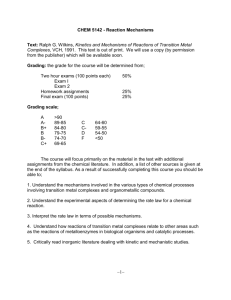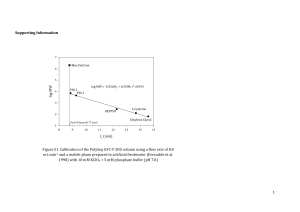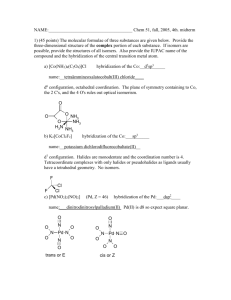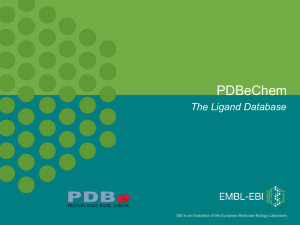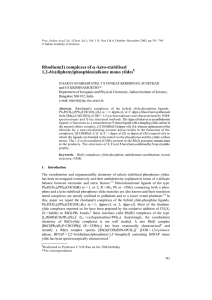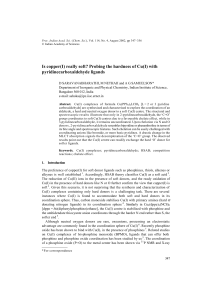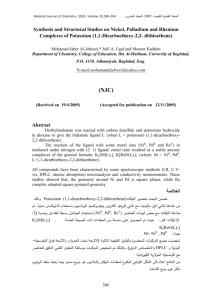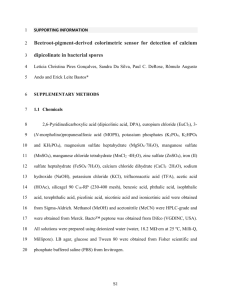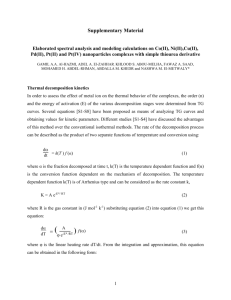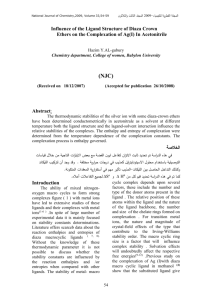Open Access version via Utrecht University Repository
advertisement
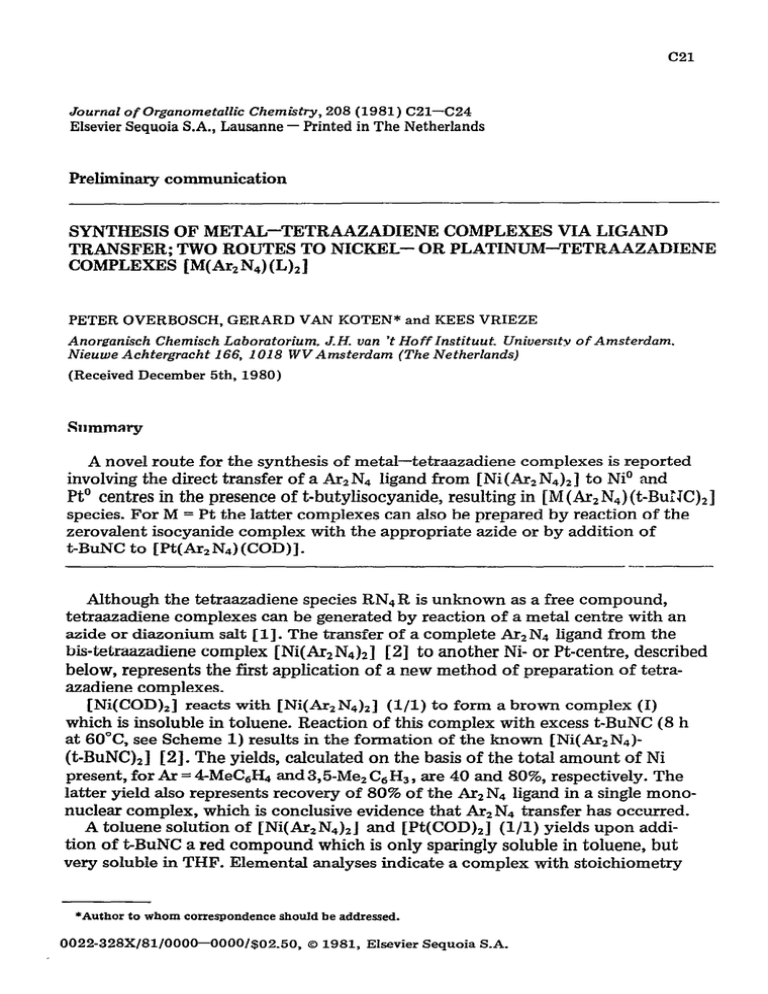
c21
Journal of Organometaliic Chemistry, 208 (1981)
C21-C24
Elsevier Sequoia S.A., Lausanne - Printed in The Netherlands
Preliminary communication
SYNTHESIS OF METAL-TETRAAZADIENE
COMPLEXES VIA LIGAND
TRANSFER; TWO ROUTES TO NICKEL- OR PLATINUM-TETRAAZADIENE
COMPLEXES [M(Ar,N,) (L),]
PETER OVERBOSCH, GERARD VAN KOTEN* and KEES VRIEZE
Anorganisch Chemisch Laboratorium. J-H. van ‘t Hoff Insfituut, Universrty of Amsterdam,
Nieuwe Achtergracht i66, 1018 WVAmsterdam
(The Netherlands)
(Received December 5th, 1980)
A novel route for the synthesis of metal-tetraazadiene
complexes is reported
involving the direct transfer of a Ar*N, ligand from [Ni(Ar* N4)*] to Ni” and
Pt” centres in the presence of t-butylisocyanide, resulting in [R/I(Arz N4) (t-BuTJC),]
species. For M = Pt the latter complexes can also be prepared by reaction of the
zerovalent isocyanide complex with the appropriate azide or by addition of
t-BuNC to [Pt(Ar2N4)(COD)].
-
Although the tetraazadiene species RN,R is unknown as a free compound,
tetraazadiene complexes can be generated by reaction of a metal centre with an
azide or diazonium salt [ 11. The transfer of a complete A.r2N4 ligand from the
his-tetraazadiene complex [Ni(ArzN4)2] [2] to another Ni- or Pt-centre, described
below, represents the first application of a new method of preparation of tetraazadiene complexes.
[Ni(COD),] reacts with [Ni(Ar2N4)2]
(l/l) to form a brown complex (I)
which is insoluble in toluene. Reaction of this complex with excess t-BuNC (8 h
at 6O”C, see Scheme 1) results in the formation of the known [Ni(Ar*N,)(t-BuNC),] 121. The yields, calculated on the basis of the total amount of Ni
present, for Ar = 4MeC&
and 3,5-Me2 C6H3, are 40 and 80%, respectively. The
latter yield also represents recovery of 80% of the Ar*N, ligand in a single mononuclear complex, which is conclusive evidence that ArzNq transfer has occurred.
A toluene solution of [Ni(Ar2N4)J and [Pt(COD),] (l/l) yields upon addition of t_BuNC a red compound which is only sparingly soluble in toluene, but
very soluble in THF. Elemental analyses indicate a complex with stoichiometry
*Author to whom correspondence should he addressed.
0022-328X/81/0000-0000/$02_50,
0 1981,
Elsevier Sequoia
S-A.
c22
t-GuNC
6h
1 [Pt(CoD)2]
t-BuNC
_
60-C
[N.(Ar2N,)(t-9uNC)z]
[N,(Ar,N,),Pt(t-B”Nc)>]
6h
6o0c-
[Pt(Ar,N,)
W3”NC12]
25°C
(II)
(Ai-
SCHEME
=
4-MnC6HS
Or
3 5Me,C,H,
0’1 reocflclns
I” toluene)
1
[Ni(Ar:!N&Pt(t-BuNC)J
(II), while the IR spectra show only terminal bonded
t-BuNC (zJ(NC)2190 cm-‘(br)). The deep purple [Ni(Ar*N,),]
may be recovered
from the intermediate II by passing the red THF solution through a silica
column. This suggests that in II both ArzNq ligands may still be bonded to Ni,
with the Pt(t-BuNC&
fragment probably coordinated to one ArzNq unit. After
heating II for 8 h at 60°C in toluene, [Pt(Ar,N,)(t-BuNC),]
can be isolated in
approximately 25% yield (see Scheme 1). If I is heated in the presence of excess
t-BuNC, a mixture of [Ni(ArzNa) (t-BuNC)J and [Pt(Ar,N,) (t-BuNC),] is obtained”. The formation of [Ni(_Ar,Nq) (t-BuNC),] in this mixture can be explained by coordination of two t-BuNC units to the Ni centre following the
transfer of one of the ArzNq ligands to the Pt centre.
Interestingly the A.r,N4 ligand transfer is also observed in the direct reaction
of [Ni(ArzN.+)2] with the metal isocyanide complexes [Ni(t-BuNC)4] and
[ {Pt(t-BuNC),},]
[3], which afford [Ni(Ar,Nq)(t-BuNC)2]
and [Pt(Ar,N,)(t-BuNCj,], respectively.
Tetraazadiene ligand transfer from [Ni(Ar, N4) ($-CS Hs)] [ 21 and [Co(Ar, N4)
(v’-CsHs)] [4] to other metal centres has not so far been observed, which may
be due to the different type of bonding in these [M(Ar*N,) (n5-CsHs)] species.
A recent X-ray structure determination of [Ni(Ar* N4) (V5-CSH,)] (Ar = 4-MeC, HL
[5] has shown significant differences from [Ni(Ar2Nd)J (Ar = 3,5-Me&H,);
a
shorter central N-N bond distance of l-278(3) A was found with two longer
adjacent N-N bonds of l-344(2) and l-346(2) A (cf. the equal N-N bond
lengths of l-319(4) and l-325(3) A, respectively, in [Ni(Ar,N,),] ), while the
aryl groups are twisted 45” out of the NiN, plane (cf. the coplanarity of aryl
rings and NiN4 plane in [Ni(ArzN4)2] ).
An alternative route to the platinum-tetraazadiene complexes [Z] , namely
the reaction of [Pt(COD),]
with the corresponding azide (see Scheme 2), yielded
[Pt(ArzN,) (COD)] (III, Ar = 4MeC&,
4-CICs I&, 4-NO2 C6H4) in approximately
30% yield_ The reactions were carried out at room temperature
and proceed
more rapidly with increasing electronegativity of the substituent on the aryl
groups. Comparison of the i3C NMR shift data of the olefinic COD carbon
*Themixhrre
wasIdentiedby
the pure compounds_
FD mass spectroscopy
and comparison
of the IR spectra with those of
C24
butadiene (DAB) units [lo], a ligand which is isostructural with Ar2 N4. Whether
these intermediates react further to give the exchanged products seems to
depend on the nature of the aryl substituent, the co-ligand L and the metal.
Further research is being directed towards elucidation of the structure of the
[Ni(Ar2N4)ML2] intermediates in order to obtain insight into the mechanism of
these Ar, N4 ligand transfer reactions.
We thank -Mr. R.H. Fokkens for recording the F.D. mass spectra, Mr_ J.
Emsting for recording the 31P NMR spectra, and Dr. D.M. Grove for many
helpful discussions.
References
See S. Cemni
and G_ la Monica. Inorg. Chnn. Acta Rev.. 18 (1976) 279.
P. Overbosch. G. van Koten and O_ Cverbeek, J. Amer. Chen
Sot., 102 (1980) 2091.
M. Green, J-A-K. Howard, M. Murray, J-L. Spencer, and F.G.A. Stone, J. Chem. Sot. Dalton. (1977)
1509.
S. Otsukaand
A. Nakamura,
Inorg. Chem.. 7 (1968) 2542: M.E. Gross, W-C. TrogIer. and J.A. Ibers.
to be published.
A-L. Spek. G. Roelofsen
and A-J- Duesenberg. to be pubhshed.
M.T. Chicote. M. Green, J.L. Spencer. F.G.A. Stone. and J. Vice&e.
J. Chem. Sot. Dalton. <1979)
536; D.M. Grove, Ph.D. thesis, BristoI, 1977.
Cf.: CM. Flynn,
Jr. T.S. Viswanathan
and R-B. Martin. Inorg- NucI. Chem.. 39 (1979) 437. and ref.
cited therein.
E-0. Fischer and H_ Werner, Chem. Ber., 95 (19621703:
S. Otsuka. A. Nakamura, and Y. Tatsuno.
J. Amer. Chem. Sot.. 91<1969)
6994.
L.H- StaaI, G. van Koten, R.H. Fokkens. and N.M.M. Nibbering.
Inorg. Chin. Acta. xn nress; C-N. McEwt
and SD. Ittel, Org. Mass. Spectrom..
15 (1980) 35.
10a & van dar PoeI. G. van Koten, K. Vrieae. M. Kokkes and C.H. Stam. Inorg. Chim. Acta. 39 (1980) 197.
lob
H.-W_ Friihauf, A. Landers, R. Goddard and C. Krieger. Angew. Chem.. 90 (1978) 56: L-H- Staal.
L.H. Pohn. R-W_ Balk. G. van Koten. K. Vrieze and A.M.F. Brouwers. Inorg- Chem.. 19 (1980) 3343.
10~ L.H. Staal, L.H_ Pohn. K. Vrieze. F. Ploeger and C.H. Stam. J. Organometal.
Chem.. 199 (1980) C13.

